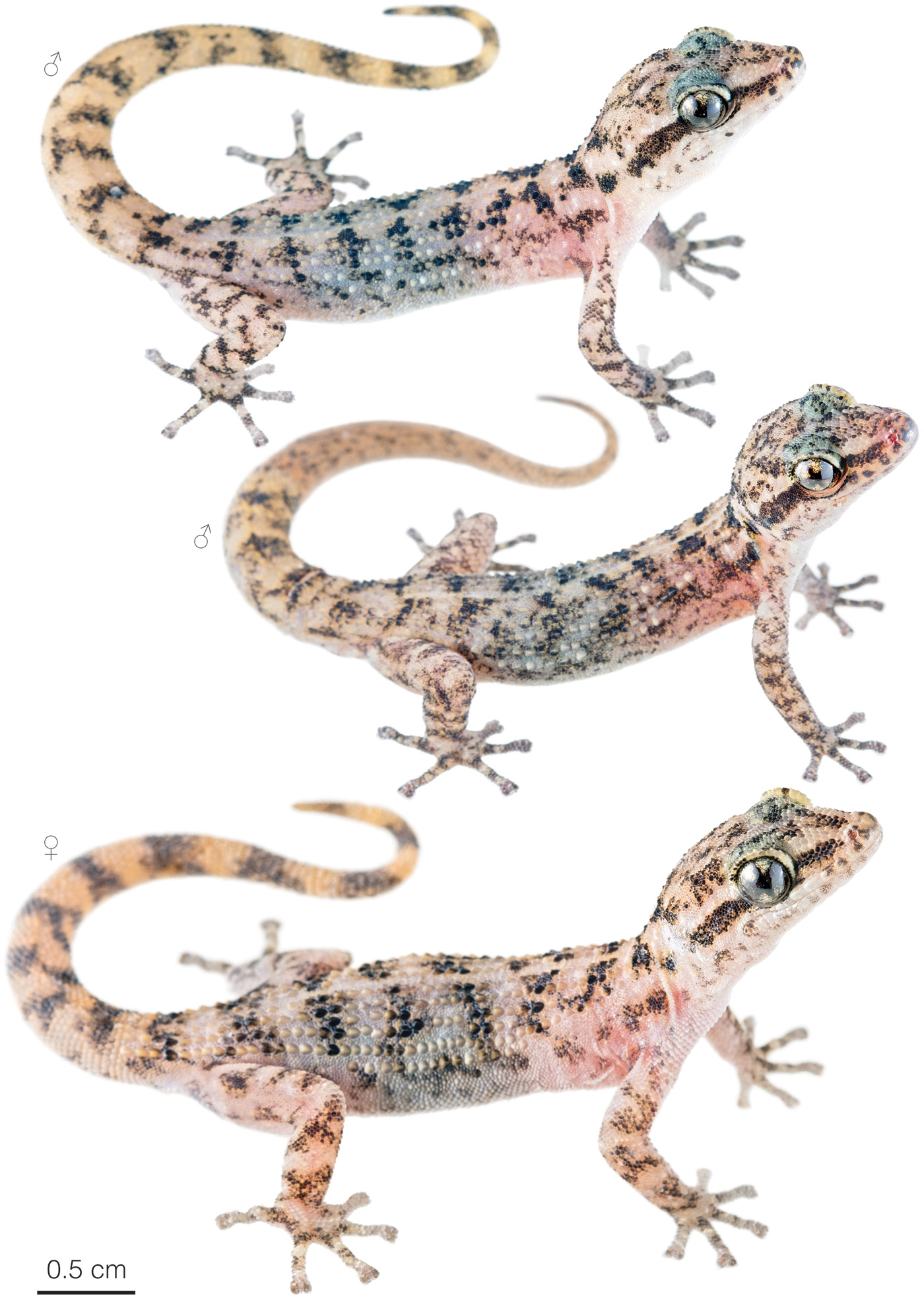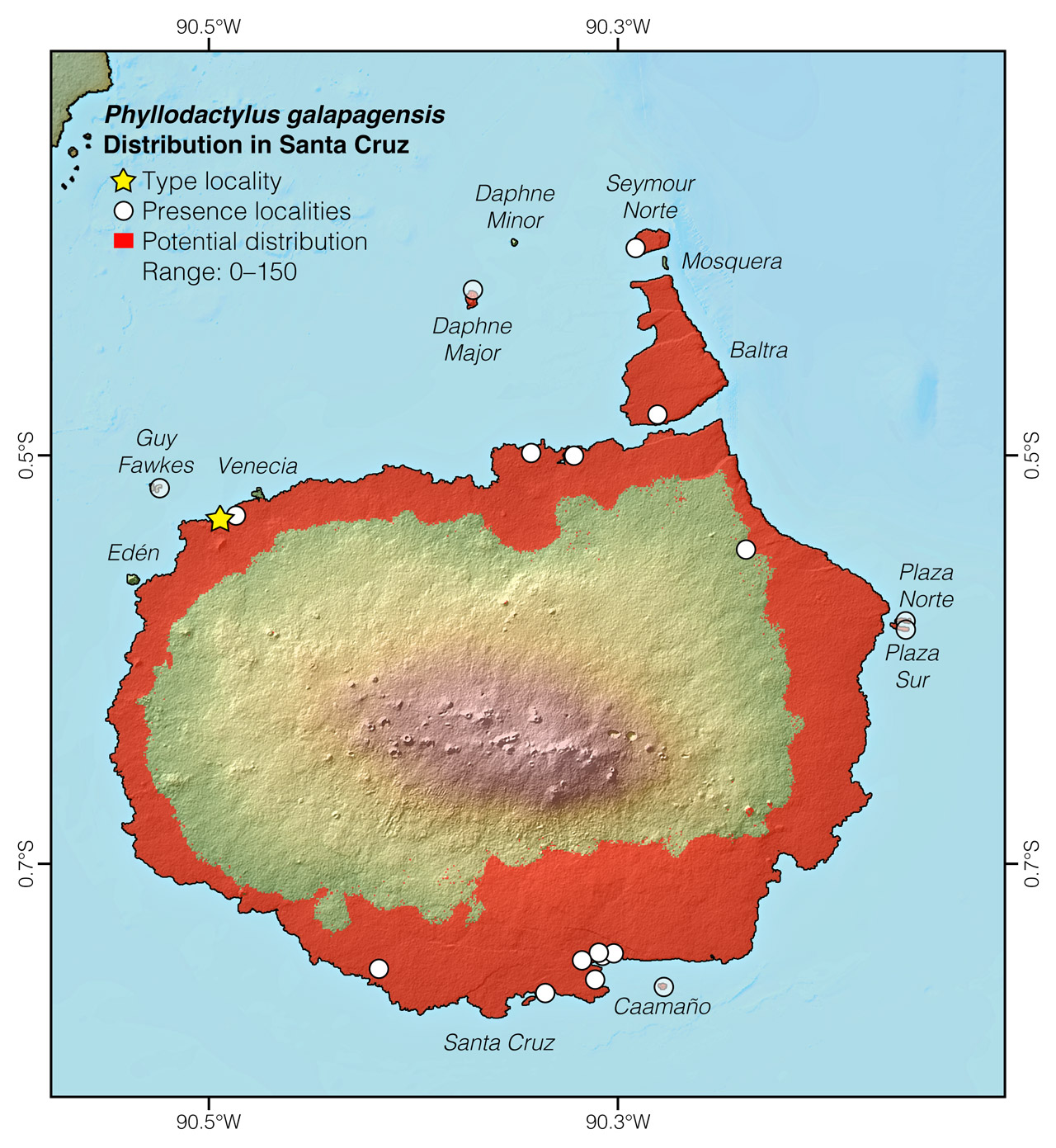Published October 10, 2019. Updated December 23, 2023. Open access. Peer-reviewed. | Purchase book ❯ |
Galápagos Leaf-toed Gecko (Phyllodactylus galapagensis)
Reptiles of Ecuador | Sauria | Phyllodactylidae | Phyllodactylus galapagensis
English common name: Galápagos Leaf-toed Gecko.
Spanish common names: Geco de Galápagos, salamanquesa de Galápagos.
Recognition: ♂♂ 9.4 cmMaximum distance from the snout to the tip of the tail. ♀♀ 9.2 cmMaximum distance from the snout to the tip of the tail..1 Geckos in general are easily distinguishable from other lizards by their nocturnal habits and vertical pupils. Phyllodactylus galapagensis is one of five (one native, four introduced) geckos occurring on Santa Cruz Island. Among these, it is the only one having narrow and rounded digital disks and a dorsal pattern consisting of irregular dark brown to black blotches on a whitish background color (Fig. 1).1 In Puerto Ayora and Baltra airport, this species co-occurs with P. reissii, a larger gecko having broad truncated digital disks and a less contrasting dorsal coloration.

Figure 1: Individuals of Phyllodactylus galapagensis from Puerto Ayora, Santa Cruz Island, Galápagos, Ecuador.
Natural history: Phyllodactylus galapagensis is a nocturnal and mostly terrestrial gecko that inhabits dry forests, shrublands, and dry grassland areas within 3 km from the shoreline.1 In natural settings, the species is found on soil or on rocks, cacti, and trees up to 3 m above the ground.1–3 It also colonizes walls and roads in human settlements, although it is less common in these habitat as it is displaced by other species of geckos, including P. reissii, Hemidactylus frenatus, and Lepidodactylus lugubris.2,4 During daytime, Galápagos Leaf-toed Geckos seek refuge under lava blocks, rocks, old dead cacti, and tree bark.2 When threatened, their usual response is to flee into crevices and are quick to shed the tail if captured. Potential predators include housecats and rats.1,5
Conservation: Near Threatened Not currently at risk of extinction, but requires some level of management to maintain healthy populations..2 Phyllodactylus galapagensis is listed in this category because the species is facing the threat of displacement by introduced geckos in areas (currently only urban) where the latter have become invasive,4 as well as predation by housecats, and, therefore, may qualify for a threatened category in the near future if these threats are not addressed. However, there is no current information on the population trend of P. galapagensis to determine whether its numbers are declining.
Distribution: Phyllodactylus galapagensis is endemic to an area of approximately 388 km2 in Galápagos Ecuador. The species occurs in Baltra, Santa Cruz, Seymour Norte, and adjacent islets of these islands: Caamaño, Daphne Major, Guy Fawkes, Plaza Norte, and Plaza Sur (Figs 2, 3).

Figure 2: Distribution of Phyllodactylus galapagensis in Galápagos. See Appendix 1 for a complete list of the presence localities included in the map.

Figure 3: Distribution of Phyllodactylus galapagensis in Santa Cruz Island. The star corresponds to the type locality: Whale Bay. See Appendix 1 for a complete list of the presence localities included in the map.
Etymology: The generic name Phyllodactylus comes from the Greek words phyllon (=leaf) and daktylos (=finger),6 and refers to the leaf-shaped fingers characteristic of this group of geckos. The specific epithet galapagensis refers to the type locality: Galápagos.
See it in the wild: Individuals of Phyllodactylus galapagensis are considered a guaranteed sighting during any herpetological night hike in the outskirts of Puerto Ayora. The best time to look for the geckos is just after sunset, when they are actively foraging on rocky surfaces.
Special thanks to Lauren Livo for symbolically adopting the Galápagos Leaf-toed Gecko and helping bring the Reptiles of Ecuador book project to life.
Click here to adopt a species.
Authors: Alejandro Arteaga,aAffiliation: Fundación Khamai, Reserva Arlequín, Ecoruta Paseo del Quinde km 56, Santa Rosa de Mindo, Pichincha 171202, Ecuador. Gabriela Aguiar,bIndependent researcher, Quito, Ecuador. and Juan M GuayasamincAffiliation: Universidad San Francisco de Quito, Quito, Ecuador.
Academic reviewer: Cruz MárquezdAffiliation: University of Rome Tor Vergata, Rome, Italy.
Photographer: Jose VieiraeAffiliation: Tropical Herping (TH), Quito, Ecuador.,fAffiliation: ExSitu, Quito, Ecuador.
How to cite? Arteaga A, Aguiar G, Guayasamin JM (2023) Galápagos Leaf-toed Gecko (Phyllodactylus galapagensis). In: Arteaga A, Bustamante L, Vieira J (Eds) Reptiles of Ecuador: Life in the middle of the world. Available from: www.reptilesofecuador.com. DOI: 10.47051/POIA1621
Literature cited:
- Arteaga A, Bustamante L, Vieira J, Tapia W, Guayasamin JM (2019) Reptiles of the Galápagos: life on the Enchanted Islands. Tropical Herping, Quito, 208 pp. DOI: 10.47051/AQJU7348
- Márquez C, Yánez-Muñoz M, Cisneros-Heredia DF (2016) Phyllodactylus galapagensis. The IUCN Red List of threatened species. Available from: www.iucnredlist.org. DOI: 10.2305/IUCN.UK.2016-1.RLTS.T48443616A48443620.en
- Van Denburgh J (1912) Expedition of the California Academy of Sciences to the Galápagos Islands, 1905-1906. VI. The geckos of the Galápagos Archipelago. Proceedings of the California Academy of Sciences 1: 405–430.
- Hoogmoed MS (1989) Introduced geckos in Puerto Ayora, Santa Cruz, with remarks on other areas. Noticias de Galápagos 47: 12–16.
- Clark DA (1981) Foraging patterns of black rats across a desert-montane forest gradient in the Galápagos Islands. Biotropica 13: 182–194. DOI: 10.2307/2388123
- Brown RW (1956) Composition of scientific words. Smithsonian Books, Washington, 882 pp.
Appendix 1: Locality data used to create the distribution map of Phyllodactylus galapagensis in Ecuador (Fig. 2). Go to the section on symbols and abbreviations for a list of acronyms used. Asterisk (*) indicates type locality.
| Country | Province | Locality | Source |
| Ecuador | Galápagos | Academy Bay | Lotti et al. 2012 |
| Ecuador | Galápagos | Baltra | Torres-Carvajal et al. 2011 |
| Ecuador | Galápagos | Black Turtle Cove | Arteaga et al. 2019 |
| Ecuador | Galápagos | Daphne Island | Torres-Carvajal et al. 2011 |
| Ecuador | Galápagos | ECCD | Lotti et al. 2012 |
| Ecuador | Galápagos | Isla Caamaño | Torres-Carvajal et al. 2011 |
| Ecuador | Galápagos | Islote Guy Fawkes | Lanza 1973 |
| Ecuador | Galápagos | Itabaca, 4.5 mi SE of | iNaturalist; photo examined |
| Ecuador | Galápagos | Las Bachas | Van Denburgh 1912 |
| Ecuador | Galápagos | Plaza norte | Torres-Carvajal et al. 2011 |
| Ecuador | Galápagos | Plaza Sur | Torres-Carvajal et al. 2011 |
| Ecuador | Galápagos | Puerto Ayora | Arteaga et al. 2019 |
| Ecuador | Galápagos | Punta Estrada | Arteaga et al. 2019 |
| Ecuador | Galápagos | Seymour Norte | Torres-Carvajal et al. 2011 |
| Ecuador | Galápagos | Tortuga Bay | Torres-Carvajal et al. 2011 |
| Ecuador | Galápagos | Tortuga Bay control post | Arteaga et al. 2019 |
| Ecuador | Galápagos | Tortuga Bay, 5 mi E of | iNaturalist; photo examined |
| Ecuador | Galápagos | Whale Bay* | Peters 1869; Lanza 1973; Lundh 1998 |